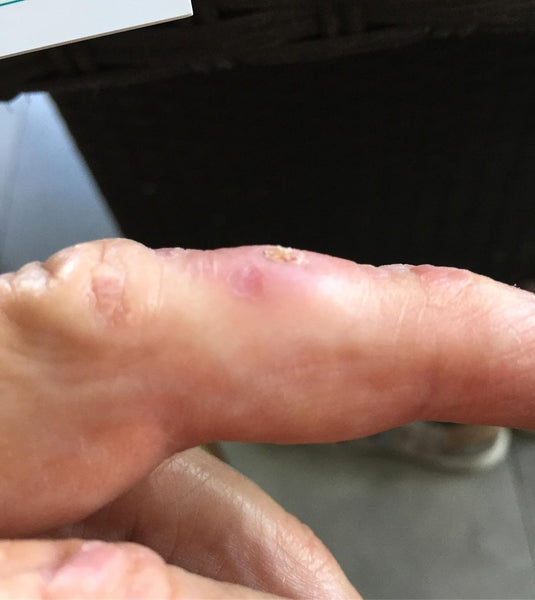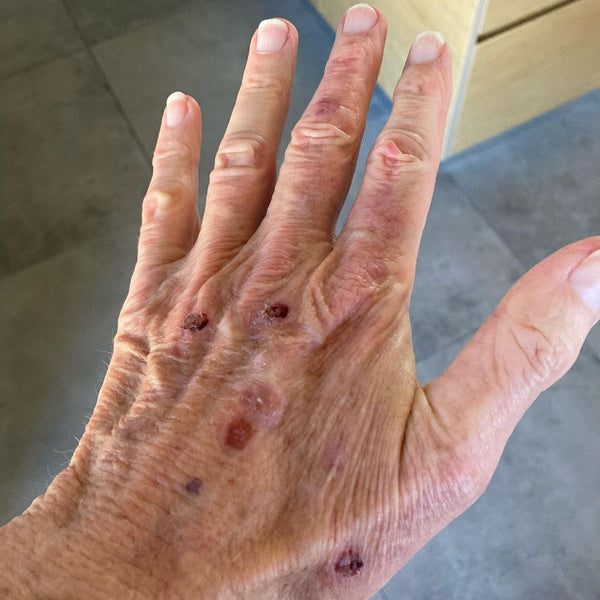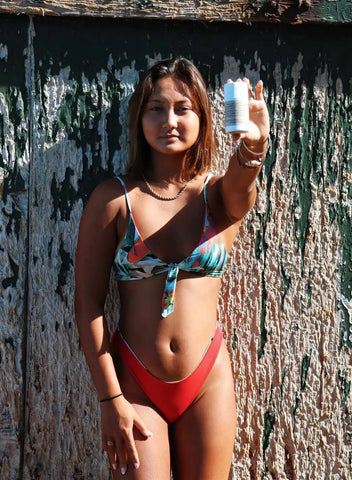A Surfing Legend’s Battle: Mark Richards’ Cautionary Tale of Skin Cancer
“The blotches on my face are from my latest visit to my skin doctor...” - Mark Richards
These chilling words and the accompanying photo of Australian surf legend Mark Richards’ blotchy, red face popped up in surfers’ social media feeds. The usually rugged-looking Richards was almost unrecognizable after a skin check revealed numerous precancerous spots on his face, hands and arms. All were burned off using liquid nitrogen by his dermatologist.

As one of professional surfing’s most decorated champions with four world titles in the 1970s, Richards spent countless hours chasing waves on brilliant sunny days along Australia’s Gold Coast. Like many surfers, he prioritized waxing his board over wearing sun protection. Despite always using sunscreen on his face, the 59-year-old admitted to rarely protecting the rest of his body.
“Stupidly more concerned about getting sun cream on my wax than getting sunburnt. Thinking back I've surfed through a lot of summers in boardshorts with my back getting fried,” Richards lamented.
That decision is now coming back to haunt him.
Squamous Cell Carcinoma Diagnosed on Richards’ Hand

Shortly after revealing the pre-cancerous facial spots, Richards disclosed another skin cancer scare - this time a squamous cell carcinoma on his finger requiring surgery and a skin graft.
Richards was astonished that after decades handling surfboards in the sun, he developed cancerous cells on his hand. "In all my years of surfing I'd never put sunscreen on the top of my hands as they don't seem to get sunburnt,” he wrote. “I was seriously wrong!"
The large bandages immobilizing his fingers illustrated the severity of the damage and how vigilantly we need to safeguard our skin. For surfers, areas like hands, feet and scalps often seem low risk, but accumulate immense sun exposure over years of paddling.
Numerous Lesions Still Sprouting Up
Disturbingly, Richards’ skin cancer battles didn’t end after the initial facial and hand procedures. Just two months later, he was back under the dermatologist’s liquid nitrogen applicator for another round of treatment.
“The blotches on my hands are from a revisit to my skin doctor for another round with the ‘Freeze Gun’!!! There were numerous precancerous spots...which didn’t respond to the recent first treatment,” Richards revealed.

After 62 years surfing under the Australian sun’s harsh rays, the damage runs deep. The spots sprouting up even after initial removals indicate how vigilant we must be to protect ourselves. Waiting too long may mean some radiation-induced skin cell mutations are irreversible.
A Wake-Up Call for All Surfers
Now requiring constant skin checks and procedures, the surfing legend continues to share his cautionary tale to inspire the surfing community. In every post, he sounds the alarm urging people to safeguard themselves from the sun and get regularly examined.
“I posted it in the hope that it would inspire a few people to get regular skin checks,” Richards wrote. Through his own recurring scares, he’s making it his mission to spread awareness so others don’t wait until it’s too late like he did.
So what lessons should surfers take from the Mark Richards skin cancer saga?
Use Sun Protection No Matter How Good You Think Your Skin Is
Richards assumed years of sunscreen on his face made him safe, but cancers sprouted up everywhere else. Good genetics that let him surf sunburn-free as a kid bred complacency. Don’t rely on skin type - diligent protection is essential.
Cover Up Completely
Merely sunscreening your face leaves large areas like backs, chests and legs vulnerable when wearing surf trunks. Richards now always surfs fully covered in a wetsuit or lycra sun shirt. Ensure suits have UPF protection and re-apply sunscreen under arm openings.
Don’t Forget Hidden Areas
Spots like hands, feet, scalps and behind knees and ears are easily neglected when applying sunscreen. Ensure full coverage across all exposed skin, especially over bony prominences.
Wear a Wide-Brim Hat
Protect thinning hair or bald spots prone to burning with an adjustable strap hat. Scalp sun damage really adds up after years of surfing.
Get Checked Annually
Prevention is better, but early detection is key. Get the full-body scan, not just spots you’re worried about. Mark skin irregularities to monitor changes. Don’t delay if any growths change shape, color or size.
Yes, surfing’s recurring skin cancer close calls are scary wake-up calls. But they needn’t deter us from chasing waves if we properly safeguard our skin. Richards’ mission is to spread vigilance so fellow surfers can enjoy the sport for life.
Let his cautionary tale serve as motivation to fully cover up, double down on sun protection, and monitor your skin closely. Stop sun damage before it stops you!
Apply Reef-Safe Sunscreen Generously
Choose mineral options over chemical sunscreens to avoid environmental contamination. Zinc oxide formulas like Real Sun Cover provide safer protection that won’t bleach reefs. Apply more sunscreen than you think necessary and re-apply every 2 hours.
Why Sunscreen is a Surfer's Best Friend
My story is a cautionary tale for all surfers. We spend a significant amount of time exposed to the sun, more so than most folks. Here's the reality:
- Sun damage is cumulative. Those epic sunburns from your youth? They add up, increasing your risk of skin cancer later in life.
- UVA rays penetrate deep. Sunscreen isn't just about preventing sunburn (caused by UVB rays). UVA rays penetrate deep into the skin, causing premature aging and contributing to skin cancer.
- Surfing = Reflection. Water reflects sunlight, intensifying your exposure.
The bottom line? Sunscreen is non-negotiable for surfers. It's not a matter of vanity – it's about protecting your skin and your health.
Finding the Right Sunscreen for Surfers
Okay, so you're convinced. But with endless sunscreen options out there, how do you choose the right one for surfing? Here's what matters:
- Broad-spectrum protection: Look for a sunscreen that protects against both UVA and UVB rays.
- Water resistance: Standard sunscreens wash off easily with water. Choose a water-resistant formula that stays put during your session.
- Reef-safe: Many sunscreens contain oxybenzone and octinoxate, which are harmful to coral reefs. Opt for reef-safe formulas that protect your skin and the ocean.
- Non-greasy and sweatproof: Nobody wants a greasy mess on their face or back while paddling. Choose a lightweight, non-greasy formula that stays put even when you work up a sweat.
Introducing Real Sun Cover: The Sunscreen Developed by Surfers, for Surfers
At Hawaiian South Shore, we understand the unique needs of surfers. That's why we developed Real Sun Cover (RSC) – a reef-safe, water-resistant sunscreen formulated specifically for our aquatic lifestyle.

Here's what makes RSC different:
- Broad-spectrum SPF 50+ protection: Blocks UVA and UVB rays for maximum sun defense.
- 4-hour water resistance: Stays on during your entire session, no reapplication needed (unless you're out for an epic multi-hour paddle).
- Oxybenzone and octinoxate free: Protects you and the ocean.
- Lightweight and non-greasy: Leaves no greasy film, perfect for paddling and catching waves.
Embrace the Sun, Protect Yourself
Surfing is a gift – a chance to connect with the ocean, experience the thrill of the ride, and soak up the sun's energy. But let's do it responsibly. Sunscreen isn't a badge of weakness – it's a sign of respect for your body and the environment.
Embrace the sun, but protect yourself. Use a high-quality, reef-safe sunscreen like Real Sun Cover, and prioritize sun-protective gear when needed. You'll thank yourself later, with healthy skin and a
SHOP RSC SUNSCREEN NOW
Read More👈
MARK RICHARDS, THE TWIN FIN, AND THE PERFECT FCSII FIN DESIGN FOR SUMMER

